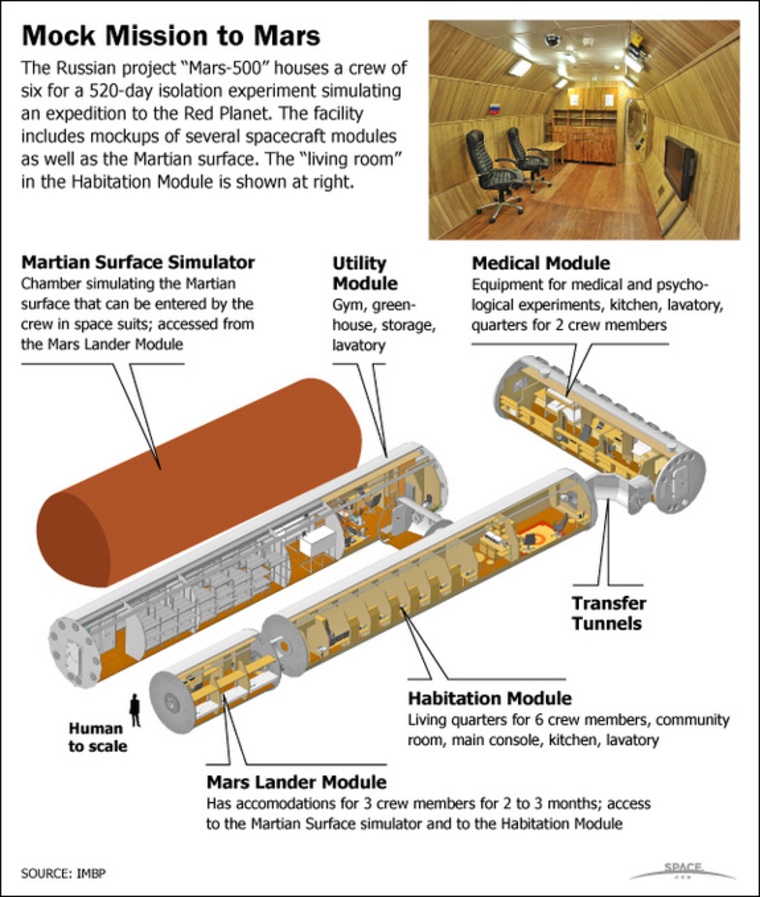The crew of a simulated international Mars mission took their first steps on an indoor Red Planet landscape on Monday, marking the halfway point in an ambitious 520-day isolation experiment to test the strains of interplanetary travel.
Two members of the six-man crew from Europe, China and Russia, who enlisted to be locked up in a mock spacecraft for a year and a half, held their first sortie after eight months of cramped living in the 1,720-square-foot (160-square-meter) module, parked in an institute on Moscow's outskirts.
Dubbed Mars500, the ambitious experiment, the first full-duration simulation of a manned flight to Mars, aims to test one of the biggest unknowns of deep space travel: the mental and physical strains of such a journey.
The idea is to mimic the timescale of a manned Mars flight — 250 days for the actual flight, 30 days in Martian orbit and on the surface, and then 240 days for the long return back to Earth. During the whole time, the crew members are shuttling through imaginary space and have limited contact with the rest of the world.
Russia's mission control center, which monitors real-life spaceflights, broadcast live footage of Russian Alexander Smoleyevsky and Italian-Colombian Diego Urbina trudging awkwardly under the weight of their 70-pound (32-kilogram) spacesuits through a dark, sand-filled and rock-strewn room meant to imitate Mars' Gusev Crater. The area has been nicknamed "Gusev Base."
”Europe has for centuries explored Earth, led by people like Columbus and Magellan. Today, looking at this red landscape, I can feel how inspiring it will be to look through the eyes of the first human to step foot on Mars,” Urbina said at the beginning of Monday's Marswalk.
“I salute all the explorers of tomorrow and wish them godspeed.”
Two more Marswalks are scheduled on Friday and Feb. 22.
Scientists with the European Space Agency and Moscow's Institute of Biomedical Problems, who are running the ambitious experiment, acknowledged that the exercise cannot hope to test all the risks of a true crewed mission to Mars, such as solar radiation and weightlessness.
But space officials said the project was much more than a glorified "Big Brother" TV show.
"In the astronaut business we know that this is tough," Christer Fuglesang, a real-life astronaut and head of the ESA's life-science unit. "There is a real risk. You can stand being with someone you don't like for a couple of months, but for such a long mission the crew have to be very social people."
He warned that after the "high" of their mock landing on Mars, the long, return journey would be the toughest period of the whole experiment.

The Mars500 volunteers, aged between 28 and 38, include a member of a real-life space program and a civil engineer. But no women were chosen for the study, which has sparked a bit of gender controversy. Several years ago, a Russian expert on space medicine said the first crews to visit Mars should be all-male because "women are fragile and delicate creatures."
Only in the toilet are the crew members free from cameras and observation.
Videos posted on the Mars500 project's blog show the men eating a mushy frozen diet, plastered with electrodes during workouts and naps, playing video games on a Nintendo Wii and singing karaoke to break the monotony.
The crew members live on food rations like those of real-life space station astronauts. Showers come every 10 days, and contact with the outside is artificially delayed and disrupted to force the crew to fend for themselves.
In an emergency drill, scientists cut off electricity to the module for over 24 hours to see how the crew would handle a crisis. Mission planners also introduce mock medical emergencies as a test.
"I am really convinced that the unique experience, which the Mars500 group continues to return to us... will be a strong asset for the future undertakings of man in its ambition to fly to the Red Planet," said Martin Zell, who heads up the ESA scientific program on the International Space Station.
The ESA, Russia's space agency and NASA have separately sketched dates for a human flight to Mars in around 30 years.
This report includes information from Reuters and msnbc.com.
